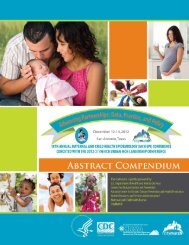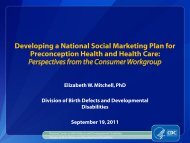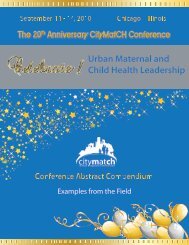Conference Abstract Compendium Examples from the ... - CityMatCH
Conference Abstract Compendium Examples from the ... - CityMatCH
Conference Abstract Compendium Examples from the ... - CityMatCH
Create successful ePaper yourself
Turn your PDF publications into a flip-book with our unique Google optimized e-Paper software.
2009 <strong>CityMatCH</strong> Urban MCH Leadership <strong>Conference</strong>Validation of fertility treatment use questions on <strong>the</strong> 2004 Pregnancy Risk AssessmentMonitoring System surveyPRIMARY CONTACT:Danielle T Barradas, PhDEIS OfficerMCHEPI Team, Division of ReproductiveHealthNCCDPHP, CDC4770 Buford Hwy NE, MS K-22Atlanta, GA, 30341Phone: (770) 488-6286Fax: (770) 488-5291Email: dbarradas@cdc.govCATEGORYPrematurity / Preterm birth / BirthweightO<strong>the</strong>r: data qualityFOCUSData FocusBACKGROUNDCO-PRESENTER(S)/AUTHOR(S):Wanda Barfield, wjb5@cdc.gov (Author)Laura Schieve, ljs9@cdc.gov (Author)Denise D'Angelo, dnd1@cdc.gov (Author)Victoria Wright, vdc4@cdc.gov (Author)Susan Manning, aci6@cdc.gov (Author)Women who conceive with <strong>the</strong> assistance of fertility treatments are at increased risk of multiple gestationpregnancies and accompanying adverse pregnancy outcomes in addition to low birth weight (LBW, 1500-2499 g) births among singletons. The Pregnancy Risk Assessment Monitoring System (PRAMS) couldhelp state health departments assess outcomes associated with fertility treatments, but a previous studysuggested that PRAMS questions about fertility treatments lacked specificity and substantiallyoverestimated ART use (estimates were 2.6-fold higher than expected) The questions were revised in2004.OBJECTIVESTo assess <strong>the</strong> validity of <strong>the</strong> revised PRAMS questions regarding various fertility treatmentsMETHODSWeighted estimates of <strong>the</strong> prevalence of births conceived using assisted reproductive technology (ART)by age, plurality, and infant birth weight in three PRAMS states (FL, MD, UT) in 2004 were comparedwith corresponding estimates <strong>from</strong> <strong>the</strong> National ART Surveillance System (NASS), <strong>the</strong> current goldstandard for ART use.RESULTSThe estimated number of ART births ascertained <strong>from</strong> PRAMS was 3,700 (95% confidenceinterval=2,300–5,200), compared to 2,939 ART births reported to NASS. PRAMS and NASS estimates ofmaternal age, plurality, and infant birth weight did not differ. For example, while PRAMS overestimated8







